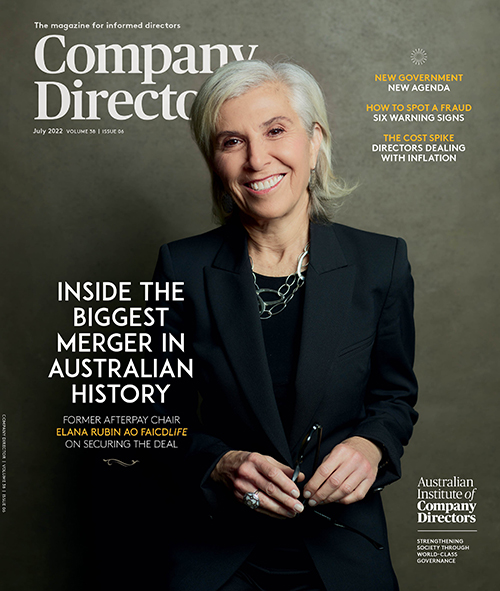Although boardroom and political gender diversity is on the rise, similar encouraging progress has not been made in increasing both cultural and skills diversity in the boardroom, writes Julie Coleman GAICD.
Progress has been made around gender diversity in boardrooms with women accounting for 32 per cent of directors across the ASX 300, according to the 2022 Board Diversity Index survey by the Governance Institute of Australia and executive search firm Watermark International. The number of boards with 30 per cent or more female directors has tripled since 2016, and the number of companies with female chairs has also increased from 30 to 37 over the past 12 months. The survey notes that by 2030, on current progress, it is possible that there will be an equal number of women and men on ASX 300 boards. (See also the AICD Gender Diversity Progress Report at bit.ly/3QdJMS4).
The same cannot be said for Australia’s cultural diversity in the boardroom. The typical ASX 300 director is currently male, of Anglo-Celtic origin, aged 60, resident in Australia, degree-qualified and with accounting/finance/banking experience/skills.
The report, which analysed five aspects of diversity on ASX 300 boards — gender, culture, skills, age and tenure/independence from 2015–21 — found that 90 per cent of board members have an Anglo-Celtic background, with three per cent European and seven per cent from non-European origins. It noted that “without vigorous, muscular advocacy” this situation is unlikely to change in the immediate future, despite the fact that the “multicultural complexion of Australia’s population continues to evolve rapidly”.
Utilise the talent
This is a missed opportunity for diverse thinking and problem-solving that is reflective of Australia’s multicultural population and our trading partners. In terms of skills and experience, only one per cent of human resources/change specialists are on ASX 300 boards, despite the human capital challenges facing boards today. Finance (32 per cent), legal (seven per cent) and IT (seven per cent) skillsets are well represented in the boardroom given financial regulations and reporting, legislative changes, and technology and digital disruptions. There has also been a steady increase (15 per cent) in the number of board members with mining/energy/resources experience, reflecting the importance of the resources sector to the Australian economy.
People and culture issues present growing risks for boards given the importance of organisational culture to governance and performance outcomes. These include labour shortages, widening skills gaps and changing generational and social expectations for organisations.
At the same time, Sex Discrimination Commissioner Kate Jenkins GAICD has warned of a rising incidence of complaints of sexual harassment and sex-based harassment complaints, (approximately 25 per cent in the year to date compared to the same time frame last year). The Australian Human Rights Commission (AHRC) is conducting its fifth national survey on workplace sexual harassment, with the results to be released in late 2022. Sexual harassment claims at Rio Tinto and AMP, and high-profile breaches to anti-money laundering and counter- terrorism finance laws by Crown Casino reinforce the importance of the ASX Corporate Governance Principles and Recommendations of integrity, objectivity, professional competence and due care, confidentiality, and professional behaviour.
Performance check
Evaluating board, committee and director performance is as important for the board itself, as it is for the organisation. The use of board evaluations to assess whether the board has a balance of skills, experience and diversity to support the organisation’s strategic objectives and governance frameworks will help it to identify gaps. Gaps can be addressed through a board renewal process that actively seeks to eliminate bias through robust recruitment and selection practices, including:
- Defining the role, expectations and key requirements of director vacancies
- Open and transparent sourcing strategies, including advertising, leveraging networking and referrals, and tapping into board internal databases
- Selection activities, including interviews, psychometric testing and trial board meetings to ensure strong cultural fit
- Onboarding new directors to enable them to quickly assimilate and add value
- Engaging external recruitment agencies for director recruitment can be expensive — human resources expertise as part of the nominations committees can streamline the process.
The rate of change in workplaces has outpaced many of the public policies, business strategies and organisational practices traditionally used to govern work, pay and employment.
As Albert Einstein said, “Insanity is doing the same thing over and over again and expecting different results.” It’s time for federal politics and Australian boardrooms to diversify so both are far more representative.
Julie Coleman GAICD is a director of Housing All Australians and a Fellow of the Australian Human Resources Institute.
Latest news
Already a member?
Login to view this content


